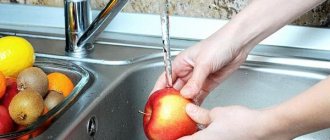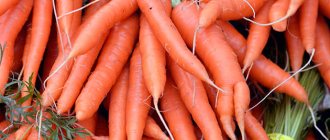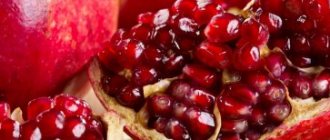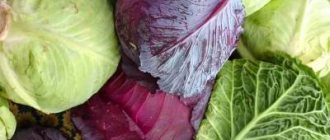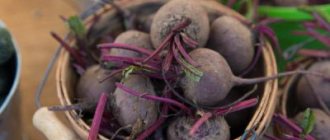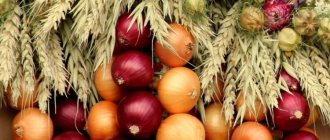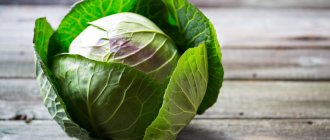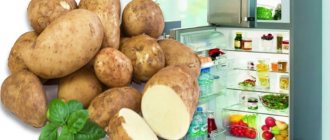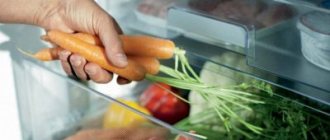One of the secrets of preparing healthy meals, according to nutritionists, is high-quality products that are always on hand. Nowadays, buying fresh produce from fields and gardens is not a problem. Markets and supermarkets offer a variety of agricultural products, the range of which is constantly updated. But you need to know how to store vegetables in the refrigerator correctly, so that even after a week they remain fresh, crispy and juicy, as on the day of purchase.
General principles for storing vegetables in the refrigerator
To ensure that the gifts from gardens and vegetable gardens remain fresh for a long time, experts recommend following the rules on how to properly store fruits and vegetables in the refrigerator:
- Do not put different vegetables in one compartment. The vegetables adjacent to the tomatoes begin to rot, and the greens begin to wither and turn yellow.
- Unripe fruits are not stored for storage. They are first placed in a paper bag along with the apple to speed up the ripening process and only then sent to the refrigerator.
- Fruits are placed in a separate container or box. They emit ethylene gas, which contributes to the rotting of vegetable crops.
- Exotic fruits are perishable products, so they are placed in a visible place and consumed within 2-4 days.
- Onions, garlic, potatoes, and ginger root do not tolerate high humidity in the refrigerator, so they begin to deteriorate faster and lose their taste. These products are best stored in a cool, dry place or at room temperature.
- Before storing vegetables, the tops are cut off, which causes them to spoil. To prevent premature drying of the fruit, leave a small tail (2–3 cm).
Freezing and preservation
If you want to store fresh vegetables for much longer than a couple of weeks, you can put them in the freezer.
Freezing is best tolerated by:
- tomatoes;
- zucchini;
- Brussels sprouts;
- Bell pepper;
- green pea;
- carrot;
- green beans.
Vegetables can be stored even longer if they are canned or pickled.
Ideal for this type of processing:
- tomatoes;
- cucumbers;
- zucchini;
- squash;
- White cabbage;
- eggplants.
Vegetables are boiled or poured raw using pre-prepared brine. Glass jars of the required volume are best suited for storage containers. Salt, vinegar and sugar are traditionally used as preservative ingredients.
Food prepared in this way can be stored for a very long time in a dark and cool place, such as a basement.
Processing products before storage
Interesting! Housewives do not have a consensus on whether it is worth washing fruits before putting them in the refrigerator. Some are sure that washing removes most microbes and prevents spoilage of food, while others believe that wet fruits, on the contrary, will rot faster.
Experts recommend sending unwashed vegetables and fruits to the refrigerator, with the exception of greens and fruits that need to be frozen in the freezer. This category of products does not like moisture very much. Therefore, in order to keep them in an edible state for as long as possible, it is necessary to ensure that they are absolutely dry. It is almost impossible to achieve this after washing, which means that even a drop of moisture can lead to the appearance of mold and rot. In addition, during washing, the skin can be damaged, which will facilitate the penetration of microorganisms into the fruit.
You should be concerned about cleanliness if vegetables and fruits were purchased at the market and in small quantities. This will remove excess dirt and assess the condition of the fruit, identifying cracked or bitten specimens. Products purchased in a supermarket are usually of high quality, besides, they have already been washed, and there is no point in repeating this procedure.
Regardless of the option chosen, before sending vegetables and fruits for storage, it is recommended:
- Sort. Spoiled fruits covered with mold, rot, and insect larvae are removed, leaving only whole, undamaged specimens.
- Clear. Remains of soil are removed with a dry rag.
- Lay it down. Delicate and soft fruits are placed separately; contact causes them to deteriorate faster.
- Provide ventilation. To do this, bags of vegetables are placed at a short distance, and several holes are cut in the bags themselves.
Important! Stone fruits, apples, pears, mangoes, avocados, melons, and tomatoes can be stored at room temperature. The exception is cherries, which, like grapes, bananas, citrus fruits, and sweet peppers, are sent to the refrigerator.
How to properly store vegetables in the refrigerator at home
At what temperature are fruits and vegetables stored in the refrigerator? The main parameters that determine the conditions for keeping vegetables in the refrigerator and allow you to create a suitable microclimate to preserve their freshness are temperature and humidity. The slightest change in one of them can shorten the shelf life of fruits and lead to their premature spoilage. However, not many people know at what temperature and relative humidity it is necessary to store fruits and berries.
Temperature
The temperature in the main chamber of the refrigerator varies depending on the location. Fluctuations in values for some models may be 10°. Therefore, it is important to arrange vegetables correctly. Several zones are intended for this purpose:
- Dry freshness zone. The temperature regime here is maintained - from -2° to +2°С. The difference is the minimum humidity levels, which is important for storing certain types of vegetables, as well as raw seafood, fish, and meat. In this zone, plant products remain fresh several times longer.
- Moist freshness zone. The temperature ideal for storing fruits and herbs is maintained here from 0° to +4°C and high air humidity. This place is also suitable for keeping fruit and vegetable products.
- Boxes for vegetables and fruits. The name of this zone speaks for itself. The boxes are separated from the main volume of the chamber by a special partition, which allows maintaining an optimal temperature of +4° - +6°C and high humidity. This place is considered ideal for storing vegetables, fruits, berries, and herbs.
Humidity
Each product category has its own moisture content standards - compliance with them will preserve its presentation and maximum vitamins:
- vegetables, fruits, berries – 80–95%;
- mushrooms – 75%.
Moisture content may vary depending on the location in the main compartment of the refrigerator.
We recommend:
How to store dried fish at home
- The “dry cold” zone does not exceed 50–60%.
- “Wet cold” department – up to 95%.
If humidity levels exceed acceptable standards, they can be reduced using a damper on the partition lid. It is not recommended to completely close it, but it is quite possible to partially reduce the air flow.
Freezing vegetables
Buy and freeze vegetables instead of buying them frozen
Unfortunately, most frozen fruits and vegetables you find at the grocery store are packaged in plastic bags. To reduce your plastic use, buy and freeze your own vegetables. You can freeze almost any vegetable except eggplant, lettuce, mashed potatoes, radishes and sprouts.
- The only downside to freezing your own vegetables is that you will only be able to buy seasonal vegetables.
- For vegetables that need to be frozen, look for them that are young and tender.
Wash vegetables before freezing them
Make sure all vegetables are completely washed and dried before preparing them for long-term storage. Place broccoli, Brussels sprouts, and cauliflower in a bowl of water with 1 teaspoon (4.9 ml) salt for 15 minutes to remove any bugs that may be hiding inside.
- Depending on how you plan to cook the vegetables, you may not need to dry them completely before moving on to the next step.
Trim or chop vegetables before freezing
Remove or trim ends of vegetables, remove tops, discard inedible stems or leaves, remove peels, and remove skins. You can also cut the vegetables into small pieces.
Dip them in boiling water to blanch them.
Heat a large pot of water on the stove. Place the vegetables in boiling water and stir with a wooden spoon. Cover the pan with a lid and let the vegetables cook for the required amount of time.
- For best results, blanch the vegetables for the required time, which ranges from 1 to 10 minutes.
- Do not blanch the following vegetables; There are other cooking methods that should be used before freezing them: beets, garlic, herbs, mushrooms, onions, bell peppers, spaghetti, tomatoes.
Refrigerate vegetables after blanching
Using a wooden spoon or slotted spoon, remove the vegetables from the boiling water and place them in a large bowl of ice water. Ice water will instantly stop the cooking of vegetables.
- Vegetables should not be left in ice water for long periods of time.
- The vegetables can remain in the ice water until you are ready to move on to the next step.
Drain and place in a container with a lid
Use a colander to remove the vegetables from the ice water. Place them on a towel to dry or place them in a salad container. Place vegetables in a resealable container or reusable bag. Then place the container or bag in the freezer and leave for up to 12 months.
- You can use glass or metal containers in the freezer or silicone bags.
Store correctly and be healthy!
Necessary storage containers
Every housewife tries to ensure proper storage of fruits and vegetables in the kitchen at room temperature, in the refrigerator and even in the freezer.
Plastic containers, wicker or wire baskets, wooden boxes, and cardboard boxes are used in the apartment. The main thing is that they have compact sizes and breathable walls. The containers are placed on the floor, racks and shelves, hung next to or above the countertop, inside special storage systems.
Long-term storage of vegetables in the refrigerator is achieved through the use of glass containers, plastic containers of various sizes with lids, as well as paper or plastic bags in which several small holes are prudently cut. Some housewives prefer to place vegetables in special boxes located at the bottom of the chamber.
Tips for freezing vegetables for the winter
If you want to please yourself with vegetable dishes even in the off-season, you can put the fruits in the freezer. Thanks to the low temperatures, they will last much longer than in or out of the refrigerator.
Here are some tips to follow:
- Only clean, high-quality vegetables should be stored for long-term storage. They also shouldn't be overripe.
- The generally accepted temperature level for freezing food is 18 degrees below zero.
- For convenience, it is better to freeze vegetables in portions so that they do not turn into one block of ice.
- It is worth putting the freshest vegetables in the freezer.
- You can store vegetables in plastic bags or plastic containers.
Do you know any interesting ways or tips for storing vegetables? Share in the comments, we will be interested to know about them!
Features of storing different vegetables
There are a lot of options for storing stocks, so before stocking it is important to consider how, where and what kind of vegetable is best stored.
In a refrigerator
Since vegetables and fruits should be stored at a temperature no higher than +3...+7°C, it is enough to allocate separate zones and two lower drawers for storage. They feel great here:
- zucchini;
- beet;
- carrot;
- peppers;
- cucumbers;
- cabbage;
- garlic;
- greenery.
Many people send tomatoes and potatoes to this compartment, but it is better to store them in natural conditions.
Cut off the tops of root vegetables
Many foods can be stored in the refrigerator longer if the tops are cut off first. These include beets, carrots, turnips, radishes and radishes. Experts advise cutting off the tops, and not “tearing off” or “twisting”. It needs to be cut with a knife, without leaving even tiny petioles.
At the same time, you should not peel and wash root vegetables - as mentioned earlier, washing will speed up the spoilage of the food.
It is better to store onions and garlic separately. Photo: Wikipedia

